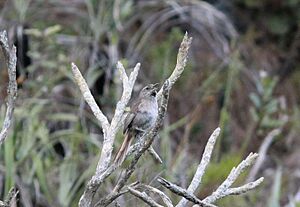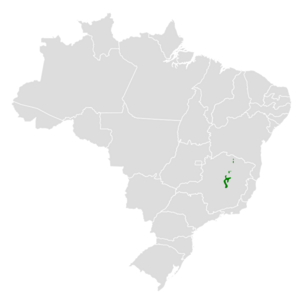Cipo canastero facts for kids
Quick facts for kids Cipó canastero |
|
|---|---|
 |
|
| Conservation status | |
| Scientific classification | |
| Genus: |
Asthenes
|
| Species: |
luizae
|
 |
|
The Cipo canastero (Asthenes luizae) is a special kind of bird that lives only in Brazil. It's part of the ovenbird family, called Furnariidae. This bird is considered Near Threatened, which means its population is getting smaller, and we need to help protect it.
Contents
About the Cipo Canastero
Scientists discovered the Cipo canastero in 1990. They found it in a place called the Serra do Cipo. Scientists study how living things are related and how they get their names. This is called Taxonomy. Some scientists think this bird might be so unique that it should have its own group!
What Does It Look Like?
The Cipo canastero is about 17 centimeters (about 6.7 inches) long. It weighs between 25.5 and 30.5 grams (about 0.9 to 1.1 ounces). That's about as much as a few quarters! It has a short beak and a tail that's not too long. Both male and female Cipo canasteros look the same.
They have a narrow whitish stripe above their eyes, like an eyebrow. A dark brown or blackish line goes through their eyes. Their face is mostly gray-brown with thin black streaks. The top of their head is warm brown, and their back and rump are grayish brown. Their wings are mostly dull dark brown. The inner tail feathers are dark brown, and the rest are a reddish-brown color.
Their chin and the middle of their upper throat are white with thin black streaks. The sides of their throat and their belly are gray. Their eyes are dark, and their beak is dark gray with a lighter gray base. Their legs and feet are a dull pinkish-gray.
Where Does It Live?
The Cipo canastero lives in a few spots in the Espinhaço Mountains in southeastern Brazil. It likes areas with rocky outcrops and bushes in grasslands. These grasslands are called campos rupestres. You can find them at elevations from 900 to 1500 meters (about 2,950 to 4,900 feet) high.
How the Cipo Canastero Lives
Staying in One Place
The Cipo canastero doesn't migrate. It stays in the same area all year long.
What Does It Eat?
This bird eats arthropods, which include insects and spiders. It usually looks for food alone or with another bird. It finds its meals by picking them off rocks and the ground.
Building a Nest
The Cipo canastero builds a round or cylinder-shaped nest using sticks. It places its nest close to the ground in a bush. We don't know much else about how they raise their young.
What Does It Sound Like?
The Cipo canastero's song sounds like a series of about 12 notes that go down in pitch, like "tseep-tseep---". Its call is a high "tjip".
Protecting the Cipo Canastero
The IUCN (International Union for Conservation of Nature) has changed the Cipo canastero's status over time. It was once considered Endangered, then Vulnerable, and since 2011, it's been listed as Near Threatened. This means it's not in immediate danger of disappearing, but its population is decreasing, and it needs our help to survive.
The Cipo canastero lives in a small area, and its habitat is not continuous. Scientists believe there are about 10,600 adult birds left, and their numbers are going down. One big problem is a bird called the Shiny Cowbird. This cowbird lays its eggs in the Cipo canastero's nest, which can harm the Cipo canastero's babies.
Fires that happen often during the dry season are also a threat, especially with climate change making things drier. Also, more than 40% of the bird's habitat is affected by mining. Even with these challenges, there's hope! The bird is fairly common in some places, and it lives in at least two national parks. In 2000, more Cipo canasteros were found in a new area, which was good news.


